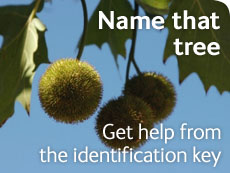Lime
Tilia species
ID check
- Leaves are alternate in arrangement, not divided into separate leaflets and are deciduous.
- Leaves are less than 3 times as long as they are broad. They are not indented into lobes. The edges are toothed, but the teeth may be very small.
- Bark is greyish or brown.
- Fruits are dry.
Description

Lime tree © Bob Press
Tree
Generally tall trees, up to 45m.
Crown
Domed. Most species have upwardly angled or arching main branches. The smaller branches and twigs are hanging in some species.
Leaves
Generally heart-shaped. They are always hairy on the underside but the hairs may be confined to the angles between the midrib and the main veins. Silver limes have leaves with dense silvery hairy on the underside.
Flower clusters
Very distinctive. Each loosely hanging cluster has a long stalk attached for part of its length to a pale greenish, narrowly oblong bract (leaf-like structure).
Flowers
5-petalled, white or yellowish and sweet-scented.
Fruit
A hard, egg-shaped to globe-shaped nut, 6–12mm long. They may be hairy and have longitudinal ribs.
Notes
The flowers of limes attract numerous bees. The trees also attract aphids - the leaves, ground and any objects beneath the trees such as cars may become sticky with a sugar-rich substance called honeydew that the insects produce.
Images

Lime tree flowers.
© Bob Press
Lime tree fruit.
© Joseph O'Brien, USDA Forest Service, United StatesForestry Images Tilia cordata P. Mill. http://www.forestryimages.org/browse/detail.cfm?imgnum=5045024 Creative Commons Attribution 3.0 United States License.
Lime tree leaves.
© Università di Trieste, Dipartimento di Biologia. Photo: Andrea Moro
Lime tree.
© Bob PressDiagrams
These diagrams explain some of the important tree and plant parts.
Flower

Leaf parts
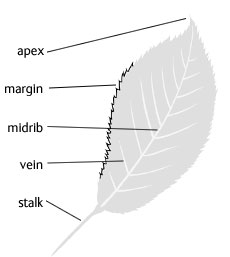
Leaf shapes
These diagrams show the different leaf shapes you might come across on your survey. Leaf shapes are important for identifying trees.
Palmate leaf
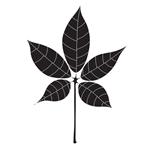
Palmately lobed leaf
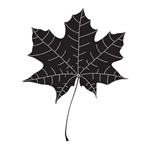
Pinnate leaf
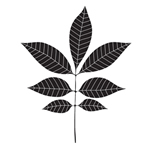
Pinnately lobed leaf

Leaf arrangements
The way leaves are arranged on a stem can be important for identifying trees.
Opposite leaves

Alternate leaves
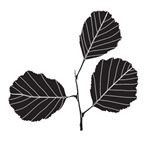
Glossary
These definitions explain some of the trickier words and phrases used in these pages.
Alternate – the arrangement of leaves on a stem - the leaves attach at different but alternating points, rather than opposite points.
Anther – the part of the stamen that contains pollen.
Apex – the top or end; the tip of a leaf for example.
Bract – a leaf-like structure, usually found below the flower or fruit.
Bud scale – usually a type of modified leaf that encloses and protects a bud.
Catkin – slender inflorescences made up of small flowers, usually reduced to the male and female parts. Catkins are typical of wind-pollinated trees.
Coniferous – trees that have cones, and needle or scale-like leaves.
Crown – in a tree, everything above the trunk.
Deciduous – a tree that sheds its leaves all at once in the autumn.
Evergreen – a tree that retains its leaves all year round.
Girth – the circumference of something, like the trunk of a tree.
Gland (of a leaf) – a small organ on a leaf that gives out oils or similar substances.
Inflorescence – the arrangement of all the flowers on a tree. The shape is used to help identify the plant.
Key – a tool used to identify groups and species of living things.
Leaflet – a subdivision of a leaf - it may look like a leaf but is attached to the leaf stalk or midrib, not to the shoot.
Lobe – a rounded or pointed section of a leaf, not divided into a leaflet.
Margin – the edge of a leaf.
Midrib – the central vein of a leaf.
Native – a tree that occurs naturally in an area, as opposed to a non-native tree that has been introduced.
Opposite – the arrangement of leaves on a stem - the leaves attach in pairs at the same point, opposite each other, rather than attaching at alternate points.
Palmate – a leaf shape in which the lobes or leaflets radiate from a single point, like fingers from a hand.
Petals – usually larger and more brightly coloured than sepals.
Pinnate – a leaf shape in which the lobes or leaflets are arranged on both sides of the stalk or midrib like a feather.
Pollarded – when the upper branches of a tree have been cut back to encourage new growth.
Sepals – the outermost parts of a flower which cover and protect the flower when it is in bud. They are usually green.
Side shoots – short, spur-like shoots growing from the main shoots.
Spike – an elongated cluster of flowers; a type of inflorescence.
Stalk – the structure that supports the blade of a leaf.
Stigma – the part at the end of the style. It is covered with a sticky substance that pollen adheres to.
Stipule – a small, leaf-like structure, found where the leaf connects to the stem.
Style – a tube-like structure in the centre of a flower that supports the stigma.
Trunk – the woody stem of a tree, before the branches.
Urban forest – the trees in our towns and cities.
Whorl – 3 or more leaves or needles circling around a stem.

